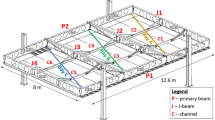Abstract
The knowledge in the field of structural fire engineering has been greatly advanced through assessment of a number of real fires (WTC, Torre Windsor, Broadgate, etc.) and, especially, by the Cardington series of full scale structural fire tests. This knowledge has been used to validate and verify the use of computational finite element models that have expanded the range of structures that can be investigated under severe fire exposure. This paper presents a selection of key lessons learned by the authors through the assessment of structures in fire for real commercial building projects. The key areas of sensitivity that have been encountered are described and a discussion of each point presented. The paper is aimed at describing potential weaknesses that have been observed in the commercial work of the authors, often driven by the requirements for efficient ambient structural design. The paper concludes with some suggested advice for structural engineers aimed at increasing the general robustness of building structures. This is based on designing out as far as possible in the ambient design of a structure the potential weaknesses identified in past project work.



















Similar content being viewed by others
References
Steel Construction Institute (1991) Structural fire engineering: investigation of Broadgate Phase 8 fire, Ascot.
British Steel plc (1998) The behaviour of multi-storey steel framed buildings in fire. Technical report, Swinden Technology Centre.
NIST (2005) Federal building and fire safety investigation of the World Trade Center disaster: final report on the collapse of the World Trade Center Towers, NIST NCSTAR 1, September 2005.
NIST (2008) Federal building and fire safety investigation of the World Trade Center disaster: structural fire response and probable collapse sequence of World Trade Center Building 7, NIST NCSTAR 1–9, November 2008.
Heise A, Flint G, Lane B (2007) Effect of fire on tall buildings: case study. In: 3rd International conference on steel and composite structures 2007, ICSCS07, pp 705–712.
Pozzi C, Lane B, Lamont S, Heise A (2006) The role of large strains and consequent mitigation measures for buildings in fire. In: Proceedings of the 4th international workshop on structures in fire, SiF 2006, vol 1, pp 487–498.
Lamont S (2001) The behaviour of multi-storey composite steel framed structures in response to compartment fires. PhD Thesis, University of Edinburgh.
Partners in Technology Report (2001) Behaviour of steel framed structures under fire conditions. Main report, University of Edinburgh.
Allam AM, Burgess IW, Plank RJ () Simple investigations of tensile membrane action in composite slabs fire, paper 03.02. In: Proceedings of the international conference on steel structures of the 2000s, Istanbul, (2000) pp 327–332.
Bailey C (2003) New fire design method for steel frames with composite floor slabs, FBE Report 5.
BSI (2004) Eurocode 2: design of concrete structures. General rules and rules for buildings, BS EN 1992-1-1.
BSI (2004) Eurocode 4: design of composite steel and concrete structures. General rules and rules for buildings, BS EN 1994-1-1.
SCI, Design of composite beams with large web openings: in accordance with Eurocodes and the UK National Annexes, Publication 355, 2011.
Jowsey A, Lim L, Lane B (2009) Structural fire analysis for a perimeter braced-frame structure. Application of structural fire engineering. Prague.
Nadjal A et al. (2011) Full-scale fire test on a composite floor slab incorporating long span cellular beams. Struct Eng 89(21):18–25.
Flint G (2005) Fire induced collapse of tall buildings. PhD Thesis, University of Edinburgh.
Al-Jabri KS, Davison JB, Burgess IW (2008) Performance of beam-to-column joints in fire—a review. Fire Saf J 43(1):50–62.
Dai XH, Wang YC, Bailey CG (2009) Effects of partial fire protection on temperature developments in steel joints protected by intumescent coating. Fire Saf J 44:376–386.
Flint G, Lim L, Jowsey A, Sarrazin H, Lamont S, Lane B (2010) Intermediate detail modelling of structural connections in fire using shell elements. In: Proceedings of the 12th international conference—Interflam 2010, vol 1, pp 45–55.
European Research Fund for Coal & Steel (2009–2012) Design of composite joints for improved fire robustness—COMPFIRE, Grant Agreement Number RFSR-CT-2009-00021.
Acknowledgments
The authors would like to acknowledge the assistance of Dr Allan Jowsey in several of the projects upon which this paper is based. Similarly the work in this paper has been greatly assisted by on-going collaboration with the University of Edinburgh.
Author information
Authors and Affiliations
Corresponding author
Rights and permissions
About this article
Cite this article
Flint, G., Lamont, S., Lane, B. et al. Recent Lessons Learned in Structural Fire Engineering for Composite Steel Structures. Fire Technol 49, 767–792 (2013). https://doi.org/10.1007/s10694-012-0291-8
Received:
Accepted:
Published:
Issue Date:
DOI: https://doi.org/10.1007/s10694-012-0291-8




